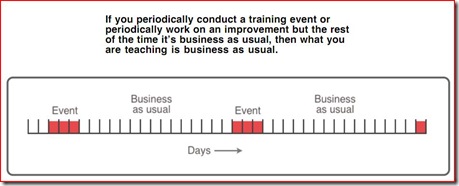There is an interesting thread developing on the NWLEAN discussion group. Kris Hallan, a regular reader here, asked a great question about the contributions of the industrial engineering pioneers to what, today, we regard as “lean production.”
This, in turn, sparked some debate about whether Taylor, the Glibreths, and others were actually following lean methods; about whether traditional industrial engineering is bogged down in over analysis, and a host of other issues.
Because not all you are following NWLEAN, I wanted to share my thoughts here as well.
The pioneers all did very good work advancing the field of knowledge.
The Gilbreths, for example, are credited with the realization that “time is the shadow of motion.”
Ohno and Toyoda were both adamant that everything they applied to build cars was simply an extension of what they saw at the Rouge plant.
The neat thing about knowledge and technology is that each generation has an opportunity to build on the last. Sometimes this is incremental, sometimes it is a profound shift. But in either case, it is the previous work that establishes the foundation – either something to extend, or a refutable hypothesis to test and reject.
If I really look at the shift that separates traditional I.E. from the more modern approach, it is in who holds the knowledge of the process AND how to improve it.
Taylor separated thinking about the process from determining the best way to perform it. He (and the Gilbreths) learned to observe with a keen eye, and optimize the motions he saw. Great stuff. Nobody did that before. Everything we do today is built on that foundation.
Today I see two levels of lean practice.
The first, and far more common, is the “outside expert” – the kaizen workshop leader, for example. In this model, this expert comes from outside the actual process. He acknowledges that the people doing the work probably know the best way to do it. But the work of exactly HOW to improve things – the magic of kaizen if you were, belongs to the expert. He is the one who facilitates improvements. While “process improvement” is the domain of the people doing the work, the “process of improvement” is owned by the outside expert.
So the skill of “improvement” is separate from the skill of “doing the work.”
I see this all of the time. Its dark side is manifested in “How do I make them follow standard work?” as if that is even possible through coercion or some punishment/reward system.
This is really an extension of the Taylor model of separating “thinking” and “doing.” In this case, however, it is “thinking about how improvement should be done” and “doing the improvements” vs. the work itself.
But something slightly different is happening in the organizations I see pulling ahead.
In those, the “skill of how to improve” is also manifested in the people doing the work. “Improvement” is part of that work itself, not something separate. There is time and resource specifically allocated to it, just as there is for production. EVERYBODY is focused on not only making improvements, but also improving how they do improvements themselves.
To the outside observer, the difference in the teaching and implementation processes are very subtle. But the difference in the culture and results that emerge can be profound.
The key difference is in letting go, finally, of the Taylor model and working to incorporate the knowledge and skill of process improvement into the entire organization – everybody – rather than keeping it in a small cadre.
I think this is one of the distinctions between a practitioner and a true sensei.
